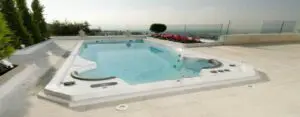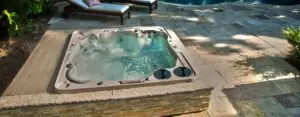August 13, 2025
Category: Swim Spa
Many of our clients dream of adding a swim space at home but it’s a more complex decision than it first appears. As someone who’s helped hundreds of families navigate this choice firsthand, I can say this: it’s not just about cost or design. It’s about how you’ll use it, how much time you must maintain it, and what kind of value it brings to your everyday life. So, let’s walk through the practical differences between a traditional home swimming pool and a swim spa.
Is a home swimming pool worth the money?
A home swimming pool instantly changes the look and feel of your garden but it comes with long-term costs few people anticipate. Heating alone can cost over a thousand pounds a year, especially for uncovered outdoor pools.
Installation involves more than digging a hole and tiling it. Think drainage, structural work, edging, filtration, and, in many cases, planning permission. Much of that cost lies in the groundwork, which is easy to underestimate. For most UK homes, unless the pool is indoors or covered, the practical swimming window is often just 4–6 months.
You’ll also need to think about ongoing operational costs such as pumps, lights, cleaning equipment, covers, and chemicals. It’s not just the upfront investment. You’ll likely face repair bills and liner replacements over the years. Some homeowners even decide to decommission their home swimming pool because the upkeep outweighs the benefits.
Is a swim spa more affordable than a home swimming pool?
In most of the installations we’ve completed, swim spas come out ahead for cost-efficiency. These insulated, self-contained systems are built for year-round use. Once we’ve sorted the concrete base and electricals, most are up and running in just a few days.
They’re popular among people who want daily fitness or hydrotherapy, without the size or expense of a full pool. The systems we install often include hydrotherapy seating, adjustable current settings, and digital controls. Many of our clients tell us they use their swim spa more than they expected.
Compared to pools, running costs are easier to predict and manage. With modern insulation and smart heating settings, most swim spas run efficiently on a standard supply. You can even pair them with solar power or energy-saving timers to bring those costs down further.
How much space does each option really need?
Traditional pools require significant space, with few workarounds. You’ll usually need 8–10 metres minimum, plus room for access and safety barriers. That rules out a lot of urban or mid-sized gardens.
By contrast, we’ve installed swim spas in everything from roof terraces to courtyard gardens. A 4–6 metre unit is enough for a strong current, massage jets, and seating. And because it’s compact and insulated, you can place it closer to the house or inside an enclosure to extend use throughout the year.
If you’re short on space but still want a private swim solution, this makes a noticeable difference. One of our recent clients installed a swim spa beside their kitchen extension giving them a fully usable garden space without sacrificing outdoor dining or planting zones.
What hidden costs should you consider?
With pools, maintenance is a full-time consideration. Weekly checks, chemical balancing, cleaning, filter replacement it all adds up. And if you’re away often or don’t want to manage it, you’re looking at additional service costs.
Most swim spa models we recommend include self-cleaning functions, simple filter access, and remote control options. We’ve seen families and retired couples alike manage their units without needing to bring in external help. For anyone short on time, that’s a major selling point.
It’s also worth thinking about heating efficiency and water conservation. Pools often need frequent top-ups due to evaporation, particularly in warmer months. Swim spas, with their insulated covers and sealed systems, hold heat better and use less water overall.
Can you exercise in a swim spa?
Absolutely. We’ve had clients use their swim spas for everything from injury rehab to triathlon training. The adjustable current gives you a consistent swim without needing to turn or push off. It’s ideal for low-impact, full-body workouts.
Unlike a traditional pool where you need space for laps, the swim spa creates a stationary swimming experience. You’re swimming in place against resistance, which is easier on joints and perfect for interval training. Some models also include tether systems or rowing kits for cross-training.
Swim spas also support varied training styles. Some clients alternate between cardio sessions in the swim zone and recovery in the massage seats. Others use it under physiotherapist guidance for aquatic mobility exercises or arthritis relief. It’s flexible enough to support everything from family use to advanced training.
Which offers better long-term value?
Pools can be a statement feature. But in our experience, they’re not always used as much as expected. The novelty fades, and unless you’ve committed to regular maintenance and use, they can become a seasonal burden.
Most clients say their swim spa becomes part of their daily routine or evening hydrotherapy sessions. If you’re planning to stay in your home, using it daily matters more than how it looks in photos.
It’s also easier to relocate or upgrade a swim spa in future. Unlike permanent pools, swim spas aren’t fixed assets and can be relocated or upgraded with ease. That makes them appealing for homeowners who might extend, move house, or change how they use their space over time.
What do real homeowners say about the decision?
We’ve had customers who initially planned for a home swimming pool, only to switch after comparing quotes and assessing the upkeep involved. One London family we worked with opted for a swim spa after learning they’d need planning consent and extensive drainage work for a pool.
Others come in knowing they want something low-effort but high-use. Professionals with busy schedules, retirees with mobility goals, and families with growing kids all lean toward practicality. The feedback is consistent: “We get more use from it than we ever did with our old pool.”
Which option fits your life?
If you want something to impress at parties and don’t mind the extra upkeep, a traditional home swimming pool might be the right fit. But if your priority is something easy to maintain, great for year-round exercise, and simple to manage, a swim spa often ticks more boxes.
Before we recommend anything, we always ask: how do you want to use it and how often? From on-site assessments to tailored plans, our goal is to make sure what you install is something you’ll enjoy.
Need help deciding between a swim spa and a home swimming pool? Contact us to talk through your space, goals, and budget. We’ll help you make the right decision for your home.


